De Zeventiende Eeuw. Jaargang 24
(2008)– [tijdschrift] Zeventiende Eeuw, De–
[pagina 162]
| |
The ‘Solliciteur-Culturel’
| |
[pagina 163]
| |
amiable patron and wrote to Senserf: ‘I shall not in any wise be dissatisfied with the price you think fit to give, or the number you shall purchase for me.’Ga naar voetnoot4 Neither the agent's uncertainty nor his patron's apparent goodwill is exemplary of early eighteenth-century Dutch agency. What is characteristic, however, is the fact that Senserf was a wealthy merchant banker and an ‘unofficial’ diplomat for Brydges in the Netherlands.Ga naar voetnoot5 Together with his father Jacob, Walter helped Brydges - the British paymaster general of the forces abroad - arrange the forage and payment of the troops during the War of the Spanish Succession. Sending wine, snuffboxes or, in this case, paintings to London, was merely an extra, occasional service. Most agents provided those ‘cultural’ services, and Senserf had to follow suit. It was part of the job. If he wanted to stay on as an agent, he had to prove himself a man of good taste. Arranging political, economic, military and above all financial matters was the main task of Dutch agents, but - depending on the patron's lifestyle - a regular supply of luxury goods, such as paintings, could be just as important. In this article I will first posit that the network of agents active in the cultural field on behalf of foreign princes in the late seventeenth and early eighteenth century in the Dutch Republic was built on the network of the so-called solliciteurs-militaires, and second that this insight helps us understand the formation of a common Northern-European aristocratic ‘taste’.Ga naar voetnoot6 To prove my point, I will introduce an unknown source, namely the ledgers of Johan van der Bent. These ledgers are preserved in the archives of The Royal Bank of Scotland Group in Edinburgh and disclose the daily activities of such an agent around 1700 (fig. 1 and 2).Ga naar voetnoot7 The ledgers are fascinating for a number of reasons. First, they provide evidence that the agents' military and cultural activities converged. Second, they give a trustworthy indication of the huge number of European aristocrats such agents worked for. Third, they make clear that these agents purveyed all manner of luxury goods en masse for their noble ‘clientele’. The sheer volume of luxury commodities shipped from the Netherlands to aristocrats abroad gives an impression of the im- | |
[pagina 164]
| |
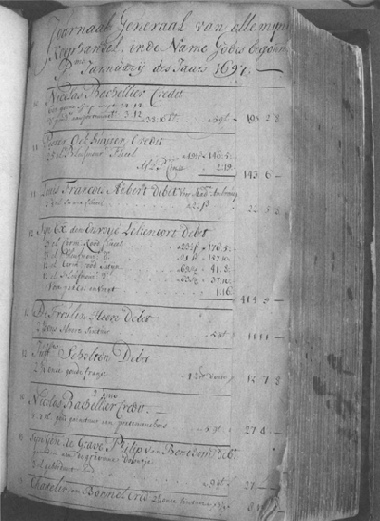
Fig. 1-2. Front pages of the Van der Bent Ledgers. London, The Royal Bank of Scotland Archives, Drummond's Dutch ledger, 1697-1709, inv. no. DR/425/1-2, 2 vols.
| |
[pagina 165]
| |
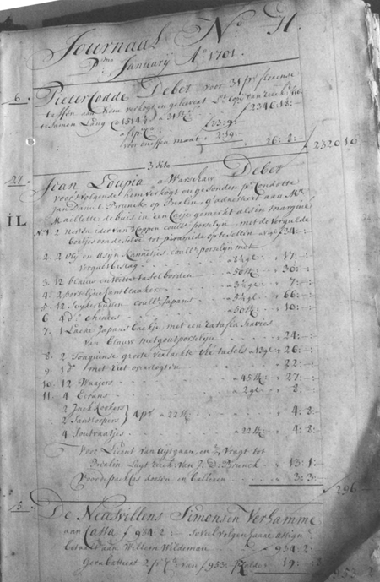 | |
[pagina 166]
| |
pact that the agents must have had on the ‘interior decoration’ of palaces all over Europe. This article is divided into three sections and ends with a brief conclusion. I begin by explaining what solliciteurs-militaires were. Then, using the example of Jacob and Walter Senserf I illustrate how haute finance, solliciteurship and art trade converged in the late seventeenth and early eighteenth centuries. And, finally, based on the Van der Bent Ledgers, I argue that solliciteurship and trade in exclusive commodities for foreign noblemen also merged around 1700. | |
Solliciteurs-militairesWhat sort of persons were solliciteurs-militaires? Although it sounds French, it is a typically Dutch phenomenon that requires some explanation. By the end of the seventeenth century and in the early eighteenth century, solliciteurs-militaires were leading Dutch merchant-bankers who provided short-term funds to finance the wars.Ga naar voetnoot8 During the War of the Spanish Succession in the early eighteenth century, they worked mainly for foreign princes who had sent in their troops as mercenaries. But this had not always been the case. The system of solliciteurs-militaires was old, and established in the Northern Netherlands during the Eighty Years War (1568-1648). After the Revolt the Northern Netherlands had no monarchy, but was ruled by stadholders. Always elected from the Orange-Nassau family, the stadholder was requested by the provinces to act as the military and political leader on their behalf.Ga naar voetnoot9 Unlike monarchs, stadholders had no steady tax income and depended entirely on the goodwill of the most powerful cities, such as Amsterdam, and several provinces. Occasionally, when a new phase in the war against Spain erupted, troops had to be raised swiftly, however, and money was needed instantly. As the stadholders were unable to provide this funding, several independent provinces had to do so instead. This was a time-consuming and ineffective process. Thus, around 1600, a group of intermediaries began arranging the financial transfers between some of the Dutch provinces and the captains of the troops. In fact, the solliciteurs acted as military bankers or ‘brokers’, immediately providing the money for the military wages to the captains and arranging the necessary forage. They subsequently requisitioned the funds from the provinces. For the financial risk they took, the solliciteurs received an agio, or a form of interest on the enormous loans. | |
[pagina 167]
| |
Since the Dutch hired foreign troops - mostly German - during the Nine Years War and the War of the Spanish Succession, the solliciteurs-militaires often also became agents for foreign princes and aristocrats.Ga naar voetnoot10 As the primary financers of the hirelings, they established good contacts with their aristocratic captains, whom they helped not only with forage and other practical, political or military problems.Ga naar voetnoot11 For instance, when war ground to a halt during the winter months, solliciteurs guided their patrons around Holland and introduced them to its elite milieu and thus the best art collections.Ga naar voetnoot12 Obviously, solliciteurs had excellent networks in the Netherlands and abroad given that they had to raise enormous sums on very short notice. The crux of the system was the overlap of the diplomatic and the financial networks. Haute finance was never far off. Although the system was subject to regulations and the number of official solliciteurs was limited after 1673, several of the system's aspects had proven their worth and were applied by most agents active in the Dutch Republic. Agents, in fact, acted as unofficial solliciteurs and did not limit themselves to the military. It was no longer the solliciteurs who operated as agents, but the agents who frequently functioned as solliciteurs in several fields, such as the military and the cultural arenas. Agents became solliciteurs in everything, as the supply of art and other luxury goods was dependent on the instant availability of capital in a broadening and accelerating art market.Ga naar voetnoot13 | |
Solliciteurs on the art marketJacob and his son Walter Senserf, the Rotterdam bankers mentioned in the introduction to this article, were not officially solliciteurs-militaires. Yet, they acted both as solliciteurs and as agents for James Brydges of Chandos. How was their network modelled on the solliciteur system? I shall use their example to describe briefly the convergence of haute finance, solliciteurship and the trade in art and other luxury goods. Jacob Senserf met James Brydges when the latter visited the Dutch Republic in the autumn of 1705.Ga naar voetnoot14 Brydges had just been appointed Paymaster-General by the English Parliament and travelled to Holland to establish a reliable network.Ga naar voetnoot15 Brydges needed it to organise the forage and payment of the troops. As paymaster, Brydges was entrusted with Parliament's enormous war budget and was responsible for ‘investing’ it in the troops abroad. Because he could not travel to the Dutch Republic himself time after | |
[pagina 168]
| |
time, to ensure that the money was well invested, he needed a reliable network in Holland, the centre of the coalition against the French, and the supply line for the troops in the Southern, Spanish Provinces. Such a network had to meet some strict standards. The individual agents' financial means were hugely important as the payment of the troops was crucial, and the money from England was mainly transferred by letters of exchange first and in cash only later and if necessary - i.e. when the balance was off. This means that agents, like Senserf, acted as bankers and provided large loans whenever required, for instance when the transfers from England were delayed. At times, the agents were also called upon to deliver weapons, bread or other necessities to the British troops active in the Southern Netherlands or to the German hirelings.Ga naar voetnoot16 Rotterdam, where the Senserfs lived, was not far from the battlefield in the Southern Netherlands. From 1705 on, Brydges maintained a weekly correspondence with Jacob Senserf.Ga naar voetnoot17 In those letters they generally discussed the progress of the war, the political situation and financial details. Since he was sending letters regularly, Brydges seized the opportunity to prevail upon the Senserfs to also buy wine, all sorts of luxury items and paintings. As a ‘gentleman’, Senserf was simply expected to deliver everything his patron desired and moreover prove himself a man of good taste. Yet, it was not always Brydges who took the initiative. When the painting collection of Adriaen Paets came up for sale in 1713, Senserf informed Brydges of this unique occasion and sent over the catalogue. Brydges was a British aristocrat who made an immense fortune by investing the war funds at the exchanges of Amsterdam, Paris and London before actually spending them on the war. Jacob Senserf, on the other hand, came from a rather more modest background. His father had been a skipper who sailed between Rotterdam and Great Britain. Jacob became wealthy trading French wines and East-Indian spices. His fortune facilitated his entry into the Rotterdam city council and he became a so-called regent, or city administrator. This position brought him in contact with the Dutch political elite, and undoubtedly with the foreign elite as well. Besides James Brydges, Philip Ludwig Wenzel Count of Sinzendorf, Prince Eugene of Savoy, the Duke of Marlborough and many others frequently visited Senserf and probably also used his services.Ga naar voetnoot18 | |
[pagina 169]
| |
Good personal contacts and confidentiality were essential to the relationship between an agent and his patron. The pre-financing of political, military, and cultural investments for the foreign princes and aristocrats by agents was a matter of trust. The sums were often so gigantic that a quick amortisation of the debts was necessary. Several agents found themselves in dire straits due to repayment delays. Agents such as Senserf often lent thousands of guilders themselves to satisfy the patron. What is more, solliciteurs, like Senserf, had to make decisions bearing on taste almost daily; the choices of such solliciteurs could influence or even significantly shape the ‘taste’ of the patron. The auction of the painting collection of Adriaen Paets in 1713 is a case in point. Senserf and his advisors had to make the choices. Whether it was wine, horses, hangings, or art, Senserf had to make the decision.Ga naar voetnoot19 In this instance, Brydges' taste in art was ‘fashioned’ by his agents abroad. As I demonstrated in my book The Auction of King William's Paintings, this was often the case.Ga naar voetnoot20 In this article, I posit that the same holds true for luxury goods, and will return to this further on. Research on late seventeenth and early eighteenth-century international art trade, thus, makes clear that war, diplomacy and cultural agency merged completely in that period.Ga naar voetnoot21 When Jacob Senserf was asked to buy paintings at the auction of Stadholder-King William 111 on 26 July 1713, the financial structure and the supporting network were in place. Senserf had learned the ropes when he first bought art for Chandos at the auction of Adriaen Paets' collection earlier that year. For the sale of King William's paintings, he set up a kind of joint venture. Matthew Decker, another confidant of Chandos and Senserf, was residing in the Netherlands in those months, as he was on a ‘diplomatic’ mission. Decker was actually a Dutchman who had left for England around 1700 and made a fortune there.Ga naar voetnoot22 He was personal banker to Brydges as well as a good part of the British aristocracy. One could call him an ‘investment banker’ and it was generally Senserf and Decker who sent letters of exchange to one another to settle Brydges' accounts in the end.Ga naar voetnoot23 The third party in the ‘joint venture’ was the Amsterdam banking firm Pels and sons.Ga naar voetnoot24 The Pels's were considered to be the richest family in the Netherlands, and their firm made money in merchant banking as well. Naturally, they also acted as agents and residents for several foreign princes, including the Swedish crown. Pels and sons were Brydges' Amsterdam ‘investment bankers’. The actual bidding | |
[pagina 170]
| |
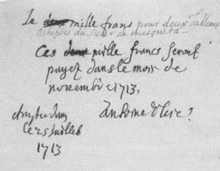
Fig. 3. Promissory note of Anton Ulrich to David Bueno de Mesquita for two paintings. Wolfenbüttel, NSSA, inv. no.Alt 19 no. 34794, Promissory note of Anton Ulrich to David Bueno de esquita for two paintings, 25 July 1713.
at the auction of the collection of William 111 was left to Marcus Bavelaer, a broker from Amsterdam and Matthew Decker's nephew.Ga naar voetnoot25 The reason for setting up this temporary ‘consortium’ had to do with the fact that Brydges, although he had shown a great interest in the collection, neglected his mail at this time. He had been occupied with ‘the joys of a well chosen married state’, as he excused himself later.Ga naar voetnoot26 He failed to send his agents clear instructions as to the finances and his artistic preferences. The agents had had to take the initiative and, as solliciteurs were wont to do, they raised the capital and invested the funds buying paintings at auction.Ga naar voetnoot27 The consortium was successful, acquiring nine pictures, worth 9,635 guilders. Bavelaer placed the bids, the ‘consortium’ arranged the finances, and Chandos was honoured by the gift, for which he could pay whenever it suited him. Chandos obtained several paintings by Anthony van Dyck, by Peter Paul Rubens, by Gerard Dou and others. All of them were masterpieces.Ga naar voetnoot28 This incident exemplifies the merging of haute finance, diplomacy and the elite art trade at the end of the seventeenth and early eighteenth century. Cultural investments in the Dutch Republic by foreign princes - be it buying paintings at auctions, silk stockings or pineapple plants - were primarily catered to by merchant bankers like Senserf. Those agent-financers functioned in most cases as solliciteurs-militaires and to the same extent as solliciteurs-culturels. They pre-invested in luxury items such as paintings, tapestry, porcelain, and so forth. They made the choices and eagerly awaited the patron's approval. It is important to note that contracts were virtually never drawn up. Most acknowledgements of debt seem to have been written down on small pieces of paper. On 21 March 1721 for example, Antoine Crozat, a major French collector, who had visited the Rotterdam collector Jacques Meyers, jotted on a scrap of paper that he would shortly pay Meyers no less than 2,800 guilders. Crozat had bought a painting by Poussin.Ga naar voetnoot29 Such | |
[pagina 171]
| |
jottings on small and seemingly un-cared for bits of paper easily went astray. Accordingly, most traces of the elite art trade are lost and in general contracts will not be found among notarial deeds. Several notes penned by Duke Anton Ulrich are still preserved in Wolfenbüttel (fig. 3).Ga naar voetnoot30 Just the appearance of these ‘reminders’ alone bespeaks evident confidence princes and agents had in one another. In this case, Anton Ulrich of Braunschweig acknowledged that he would repay his Amsterdam agent David Bueno de Mesquita 1,000 francs for two paintings. The note was signed and dated, Amsterdam 25 July: the eve of the auction of the painting collection of Stadholder-King William iii.
Naturally, Senserf senior and junior were not the only ones active - formally and informally - as solliciteurs-militaires and solliciteurs-culturels. As I demonstrated elsewhere, almost all the elite art dealers in the Dutch Republic around 1700 were active both as agents and as solliciteurs.Ga naar voetnoot31 Individuals such as Jacques Meyers, Jan van Beuningen and Adriaen Bout come to mind. They all owned impressive collections of paintings, dealt in art with foreign princes and were actively involved in politics and war funding. | |
Solliciteurship and the purveying of luxury goodsAll of the people mentioned above were involved as solliciteurs-culturels in the elite art trade, but not all solliciteurs dealt in paintings. Some of them traded luxury goods of all sorts except for paintings with the European aristocracy. Here, I will introduce an unpublished source that will illustrate for the first time the constant flow of luxury goods from the Dutch Republic to the Northern European aristocracy: the ledgers of the Johan van der Bent firm.Ga naar voetnoot32 With exceptional precision these accounts demonstrate how cultural, political and military ‘solliciteurship’ merged on a daily basis. Moreover, they make us wonder about the impact such an agent had on the formation of European aristocratic taste in the applied arts. Johannes van der Bent, the compiler of the two ledgers, was everything you would expect him to be. He was born into a wealthy family of merchant bankers. His sister Agatha married John Drummond, an agent and confident of James Brydges of Chandos and several other English aristocrats, such as Robert Harley Earl of Oxford and John Churchill Duke of Marlborough. Maria van der Bent, Johan and Agatha's mother, furnished the palaces of the Elector of Brandenburg.Ga naar voetnoot33 In short, Johan van der Bent had | |
[pagina 172]
| |
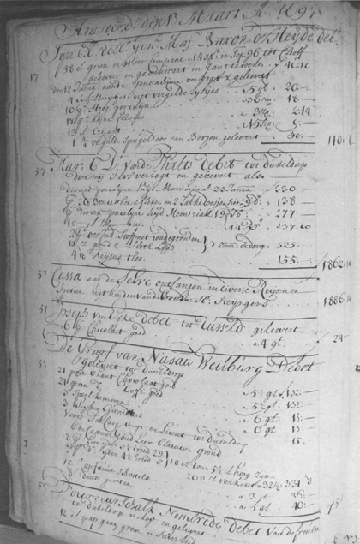
Fig. 4 Van der Bent Ledgers, 13 March 1697.
| |
[pagina 173]
| |
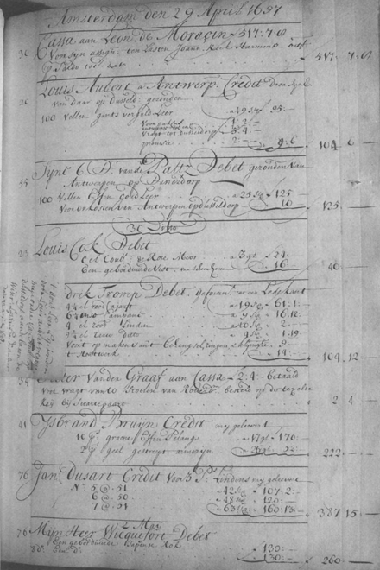
Fig. 5 Van der Bent Ledgers, 29 April 1697.
| |
[pagina 174]
| |
excellent international contacts, and this is reflected in his ledgers. From the very first page of the Journael Generaal van alle mijne Koophandel inde Name Godes begonnen Primo Jannuarij des Jaars 1697 many names from the Dutch and European elites occur as ‘customers’. I will come to this, but first, I would like to give a brief overview of the ‘merchandise’ of the Van der Bent firm. Second, I will explain how Van der Bent functioned as a solliciteur for the Elector Palatine, Johann Wilhelm and how luxury trade, solliciteurship and haute finance blended together. The firm's main products were a variety of textiles and highly finished and expensive clothing. The ledgers abound with mentions of purchases and sales of satin, velvet, gold and silver cord and other kinds of exclusive textile. Most of Van der Bent's clients - some were in fact patrons - were interested in these materials, either per foot or sewn up into fancy gowns. Although textiles were important for the business' turnover, Van der Bent should more readily be considered an ‘interior decorator’. With the exception of paintings, Johan van der Bent procured everything one might find in an elite household around 1700 for his noble clientele. The firm sold bed sheets and bedsteads, carpets and tapestry, porcelain and Delft tiles, painted fire screens and statuettes, marble floors and chimneys, an assortment of furniture, and even carved and gilded painting frames. According to the ledgers, though, it never delivered paintings. The Van der Bent firm could fill an entire palace with all the requisite fashionable hangings and furnishings, a service made use of by a good deal of the German and British aristocracy. Some examples might be in order here. I will merely give a few to make my case, but it should be borne in mind that they represent but a fraction of Van der Bent's total turnover. One of Van de Bent's main patrons was the Elector Palatine.Ga naar voetnoot34 On 13 March 1697 and on 29 April, for instance, the elector and his wife ordered porcelain, gold and silver cord and ‘goudleer’ (fig. 4 and 5).Ga naar voetnoot35 A single panel of such ‘gilded leather’ cost 25 guilders and the elector wanted no less than 100 of them. The order was placed and arranged for in Antwerp by Van der Bent. Another regular ‘client’ was Alexander Otto Count von Vehlen, a general in the army of the Elector Palatine. He was living in The Hague in 1697 and his apartments appear to have been furnished by Van der Bent.Ga naar voetnoot36 Between 8 August and 14 August 1697, Van der Bent sold furniture to the count in the amount of 5,318 guilders. The packages contained ‘Tapisserie d'Hautelisse’, a luxurious bedstead, tables, chairs, porcelain, and so forth. And these were only the more expensive luxury items; Count Vehlen's order also included sheets, tablecloths, napkins and towels, most of which were described in detail. A month later, on 9 September 1697, the Elector of Cologne bought two luxurious bedsteads, mirrors with gilded frames and several oth- | |
[pagina 175]
| |
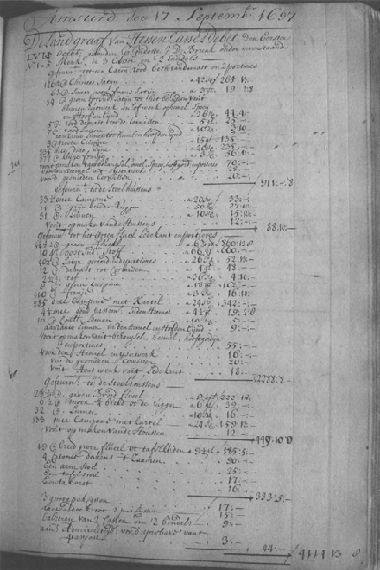
Fig. 6 Van der Bent Ledgers, 17 September 1697.
| |
[pagina 176]
| |
er goods, amounting to 2,465 guilders.Ga naar voetnoot37 A week later, it was the Landgrave of Hessen-Kassel, Karl 1, who made use of Van der Bent's services; he acquired several bedsteads, furniture and hangings for a total of more than 4,411 guilders (fig. 6).Ga naar voetnoot38 The Baron of Schönborn - most probably Johann Philipp Franz von Schönborn - received several packages in The Hague on 28 November 1697. As always, his order included porcelain and hangings, but the cases also contained little statuettes. On 26 September 1698, a black and white marble floor was shipped to Lothar Franz von Schönborn, Elector of Mainz and cousin of the Baron of Schönborn.Ga naar voetnoot39 This was followed a month and a half later by a marble chimney.Ga naar voetnoot40 The elector was busy with several building projects at the time.Ga naar voetnoot41 The Elector Palatine's court painter, Jean Francois Douven, received prints and books bought by Van der Bent from the famous Amsterdam art broker Jan Pietersz. Zomer.Ga naar voetnoot42 Occasionally an edition of Vitruvius' De Architectura was sold to patrons abroad.Ga naar voetnoot43 If necessary, Van der Bent was even prepared to go to auctions and buy tapestries.Ga naar voetnoot44 Some of Van der Bent's other patrons were August the Strong, King of Poland and Friedrich 1, King of Prussia. His clientele ranged from Curaçao to Russia, from Sweden to France. The merchandise could be anything - except for paintings it would seem. However, supplying furniture and luxury goods was merely one aspect of Van der Bent's dealings. When General Alexander Otto Count von Vehlen needed funds for the troops, Van der Bent did not hesitate to place thousands of guilders at ‘his disposition’, i.e. at his discretion. On 26 November, for example, Van der Bent lent General Von Vehlen more than 60,000 guilders!Ga naar voetnoot45 What is fascinating is not so much that Van der Bent operated as a banker for the military, and thus was a solliciteur-militair, but rather that the accounts for the luxury goods merged completely with the military funds. In his ledgers, Van der Bent made up the sum of the loan and the debts for the purchases of furniture, hangings, porcelain and spices. There was no distinction whatsoever. The Elector Palatine, Johann Wilhelm, also turned to Van der Bent for military expenditures. In the winter and spring of 1698 the elector decided to renew the uniforms of his officers. Johannes van der Bent, the elector's old confidant, was awarded the commission. The first delivery arrived on 20 January 1698. Silver braid was sent to the cap- | |
[pagina 177]
| |
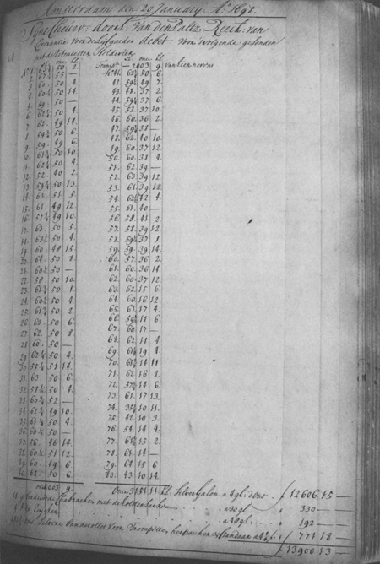
Fig. 7 Van der Bent Ledgers, 20 January 1698.
| |
[pagina 178]
| |
tain for a total of 12,606 guilders together with eleven embroidered saddle pads (330 guilders) and silver banderols for the trumpets, the kettledrums and the standard (771 guilders) (fig. 7).Ga naar voetnoot46 A month later the uniforms of several officers were replaced to the tune of 7,905 guilders.Ga naar voetnoot47 A week later, the ‘bodyguards’ received their new uniforms (9,895 guilders).Ga naar voetnoot48 Deliveries like this went on week after week until late spring of 1698. The costs amounted to several tens of thousands of guilders. Van der Bent paid for everything in advance, of course. The elector amortised these debts in instalments, with interest. The commission was de facto military solliciteurship. The unique ledgers of Van der Bent make absolutely clear how the elite trade in luxury goods, the political expenses of foreign princes, the financing of the military and the Dutch haute finance were fused. While this is fascinating to witness, even more interesting is how the aristocracy in, for instance, Düsseldorf - home to the Elector Palatine's main residence - followed the sovereign's example. They too started making use of Van der Bent's services. I mentioned the example of General Von Vehlen, but there were also Generals Statius Philipp and Ernst von Bentheim.Ga naar voetnoot49 Of the nobility living in Düsseldorf, in the first trimester of 1697 alone, the names of the Count of Nassau-Weilburg, Baron Dimanstein, Baron de Hochkirchen, the court chancellor Wizer, the imperial envoy in Düsseldorf Philipp Ludwig Wenzel Count Sinzendorf, and many others were inscribed in Van der Bent's ledgers. And the Düsseldorf aristocracy was no exception. The same was true for the aristocracy in the surroundings of the Electors of Mainz, Brandenburg, Saxony, Cologne; all patrons of Van der Bent.Ga naar voetnoot50 It will be clear by now that the Van der Bent ledgers are unique source material and that it would take several man-years of research to analyse them completely and in depth. They contain a great deal more detailed information than can be mentioned in this short notice. Almost all the ‘entries’ in the ledgers inform us of what was bought, who the buyer was and what it cost, where and to whom it had to be sent, in how many cases it was packed, how the cases were marked, how much the shipping amounted to, how it was paid for, and so on. The names of all clients and purveyors are recorded in the ledgers. In short, they can completely clarify five years of international luxury trade in the Dutch Republic. The most interesting questions, though, bear on finance and taste. I touched upon the financial arrangements in the previous paragraphs. They were based on the solliciteurs' system and I merely need to add that the use of letters of exchange and court bankers (e.g. the Jewish Gumperz family) extended the credit lines of the princes and aristo- | |
[pagina 179]
| |
crats.Ga naar voetnoot51 The first credit was given by Van der Bent himself, the second by the Amsterdam bankers of the foreign prince, the third by the home bankers of the sovereign or nobleman. In other words, when Van der Bent sold something to or bought something for one of his patrons, he was the first to pay for it. Later - and this could take months - he was reimbursed an Amsterdam banker upon receipt of a letter of exchange drawn by the patron's home banker. The prince or nobleman paid the home banker in due course. As far as ‘taste’ is concerned, some important facts must be pointed out as well, as they are of particular interest for the formation of a common Northern-European aristocratic ‘taste’. One must always bear in mind that most of Van der Bent's clients commissioned him while living abroad. This means that it was Van der Bent who chose the bedsteads, the tapestry, the hangings, the silk, the carved and gilded painting frames, the gilded leather, etcetera. And he did so for all the named patrons. As a consequence, the interior decorations of several rooms in the palaces of Johann Wilhelm, the Elector Palatine, in Düsseldorf, the Elector of Brandenburg in Berlin, the Elector of Saxony in Dresden and so on, were all largely based on Van der Bent's own taste.Ga naar voetnoot52 The success of an agent such as Van der Bent lay in the confidence and, literally, the blind faith the European aristocrats could place in him or any other agent. And what is true for the agents who arranged interior decorations is also true for the purveyors of art. Whether it was Senserf, Meyers or Van Beuningen, their patrons all relied upon their good taste and their connoisseurship, as I made clear above.Ga naar voetnoot53 Certainly, I somewhat overstated the impact of solliciteurs-culturels on European aristocrats; some patrons will have given detailed instructions to their agents. Nonetheless, many others, such as Brydges, fully trusted the good judgement of their solliciteurs. ‘As we are at a distance [we] can be but indifferent Judges of the goodness of Pictures, when there is only the subject to guide one['s] fancies by,’ Brydges explained to Senserf. What applies to art will also certainly apply to the applied arts. The impact solliciteurs-culturels had on the interiors of palaces all over Northern Europe must have been substantial. Of course, the confidence patrons had in their solliciteurs-culturels had a parlous side effect. The Dutch agents took all the risks. They were the creditors of the aristocracy. Should an agent deliver a painting or a tapestry of poor quality, the patron could refuse the goods. Subsequently the solliciteur-culturel would lose his patron's confidence, his reputation and his money. The risks were high, but worthwhile given that so much power, influence, and prestige were involved. One question remains. Did Van der Bent buy paintings for one or more of his pa- | |
[pagina 180]
| |
trons? The ledgers make no mention of any paintings whatsoever and there is no reason to assume that Van der Bent ever bought them. He was never listed as a buyer in an auction catalogue of the period, which would be expected for an agent dealing in art. This is curious: why would one sell everything but paintings? In my opinion, this had to do with connoisseurship. As I argued in my book on King William's auction, the elite international art market around 1700 was monopolised by a handful of connoisseurs. I mentioned Senserf, Van Beuningen, Meyers and Bout. Not only were they the most important ones, they were just about the only ones as well. The gap between the regular art market and the elite art market was huge and Van der Bent wisely steered clear of it.Ga naar voetnoot54 Due to prices, the network and the connoisseurship involved, collecting and trading in exclusive works of art were pleasures reserved for the European aristocracy and the happy few in the Dutch Republic. | |
In conclusionAlthough the term solliciteur-culturel is a neologism, it is a fitting description of the group of merchant bankers active in the elite and international trade in art and applied arts. The network of this small group - until now inaccurately dubbed as gentleman-dealers - was based on the structures of the solliciteurs-militaires network. They operated as purveyors of all sorts of luxury items to the European aristocracy and the sheer volume of goods shipped from Holland - as emerges from the Van der Bent Ledgers - demonstrates that they left a significant mark on the appearance of the residences of the nobility throughout Northern Europe.
Abstract - Although the term solliciteur-culturel is a neologism, it is a fitting description for the group of merchant bankers active in the elite international trade in art and the applied arts. The network of this small group - up till now inaccurately dubbed as gentleman-dealers - was based on the structures of the solliciteurs-militaires network. They operated as purveyors of all sorts of luxury items for the European aristocracy. The sheer volume of goods shipped from Holland - as emerges from the Van der Bent Ledgers - demonstrates that they left a significant mark on the appearance of the residences of the nobility throughout Northern Europe. |
|

